Iron Age - Photo gallery
Image database with photographs of ancient art and antiquities
Our image database provides photographs of ancient art and antiquities for press releases as well as for private use. All artefacts sold in our gallery are documented through professional photographs. The resulting image library contains numerous ancient Egyptian, Greek and Roman antiquities as well as ancient coins. The time span from Stone Age, over Bronze Age and Classical Antiquity until Late Antiquity is covered.The photo gallery aims at providing a vast visual archive equipped with filters and search tools. You are most welcome to search the constantly growing number of artefacts in the image library. We are also happy to authorize hyperlinks from your webpage / forum to the objects depicted in our gallery. For this purpose, please send us a short notification prior to placing a hyperlink. For almost every object high definition photographs are available and can be provided e.g. to document your collection or for scientific papers or popular science articles. If you are interested in using pictures for publications, print media or other purposes, please contact us and we will be happy to assist you.
-
 Celtic fibula from the famous Hattatt collection
Celtic fibula from the famous Hattatt collectionFibula from the La Tène II period. Found in Celtic Carnuntum. The piece is published in the standard work "Iron Age and Roman Brooches".
Price: on request Roman jar with flat handle
Roman jar with flat handlePerfectly preserved piece from a very old German collection.
Price: on request
 Roman jar with flat handle
Roman jar with flat handlePerfectly preserved piece from a very old German collection.
Price: on request Massive small Roman pot with handle
Massive small Roman pot with handleImpressive, perfectly preserved piece from a very old German collection.
Price: on request Egyptian amulet of Anubis
Egyptian amulet of AnubisThe amulet from the Late Period of Ancient Egypt was supposed to protect the dead on their way to the afterlife. From a British private museum.
Price: on request
 Egyptian amulet of Taweret
Egyptian amulet of TaweretIt shows the goddess of childbirth in the form of a pregnant hippopotamus. The amulet from the Late Period of Ancient Egypt should exert a protective function. From a British private museum.
Price: on request Roman jar, probably found in Trier area.
Roman jar, probably found in Trier area.Perfectly preserved piece from a German collection.
Price: on request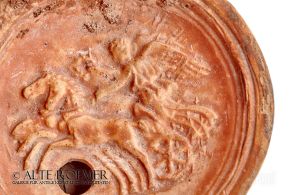 Roman oil lamp showing Victoria in biga
Roman oil lamp showing Victoria in bigaA lamp with an identical motive is on exhibition in the NATIONAL WARSAW MUSEUM. Probably found in Trier in 1913
Price: on request Egyptian amulet of Thoth
Egyptian amulet of ThothIbis headed god of knowledge and writing. 26th to 30th dynasty of Ancient Egypt. From a British private museum.
Price: on request Roman oil lamp from FETVS workshop
Roman oil lamp from FETVS workshopFrom a very old German collection. Probably manufactured in North Africa.
Price: on request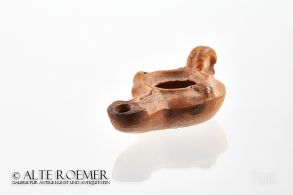 Roman oil lamp found 1913 in Trier
Roman oil lamp found 1913 in TrierPerfectly preserved piece with a particularly old known history.
Price: on request Marcus Aurelius Sestertius
Marcus Aurelius SestertiusRome, 162-163 AD. AV: Bust of Marcus Aureius, RV: Salus standing left holding scepter and patera, to her feet altar with snake.
Price: on request Egyptian pataikos
Egyptian pataikosGod or god-like dwarf. The figurine was supposed to have a magical protective function. 26th to 30th dynasty of Ancient Egypt. From a British private museum.
Price: on request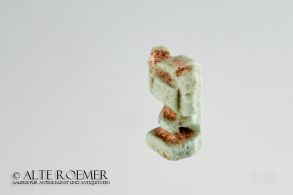 Egyptian amulet of Shu
Egyptian amulet of ShuGod of the air and the sun. The highly stylized figurine shows the ancient Egyptian god on his knees, the arms raised towards the sun. From a British private museum.
Price: on request Egyptian amulet of a falcon
Egyptian amulet of a falconThe falcon in Egyptian art can be a depiction of the god Horus or symbolize the soul of the pharao. Falcon amulets are known from the earliest times in Egyptian history. However this speicmen dates to the Late Dynastic Period of Ancient Egypt.
Price: on request Egyptian amulet of a hare
Egyptian amulet of a hareThis type of amulet was popular in the Late Dynastic Period of Ancient Egypt. It should endow its wearer with fertility and rapidity of movement. The piece was exhibited in an early 20th century private museum.
Price: on request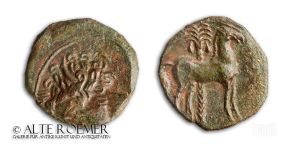 Zeugitania - Carthage bronze
Zeugitania - Carthage bronzePerfectly preserved extremely fine piece with nice green patina
Price: on request Egyptian scarab amulet
Egyptian scarab amuletNice amulet from the Late Dynastic Period of Ancient Egypt. The scarab was exhibited in an early 20th century private museum.
Price: on request Rare Nero Aureus
Rare Nero AureusRome, 64 - 65 AD. The reverse shows the emperor with his second wife, Poppaea Sabina. Rare (R2).
Price: on request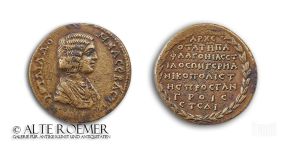 Extraordinary rare Julia Domna bronze from Paphlagonia
Extraordinary rare Julia Domna bronze from PaphlagoniaThe only specimen currently offered on the international numismatic market known to us. The coin praises the city of Gangra-Germanikopolis as the "altar of gods" and the oldest city of all Paphlagonia.
Price: on request Cylinder seal of red stone
Cylinder seal of red stoneThe cylinder seal is made of beautiful red limestone. A figurative scene is engraved.
Price: on request Mesopotamian cylinder seal with abstract scene
Mesopotamian cylinder seal with abstract sceneThe milky white stone is engraved with a scene that stands out by its high degree of abstraction. Late Uruk to Djemdet Nasr period, around 3000 BC.
Price: on request Mesopotamian cylinder seal with fighting scene
Mesopotamian cylinder seal with fighting sceneThe scene shows a fight between hero and lion with animals. Early Dynastic Period III, around 2500 BC.
Price: on request Akkadian cylinder seal of shell core
Akkadian cylinder seal of shell coreTwo lions are fighting with two buffalos. The balance and detail of the scene is an impressive demonstration of the Akkadian seal engraver's skill. Old Akkadian, around 2300 BC.
Price: on request Egyptian ushabti from the Third Intermediate Period
Egyptian ushabti from the Third Intermediate PeriodFunerary statuette of faience with black paint. The opposed hands might indicate Tanis as origin. Third Intermediate Period of Ancient Egypt.
Price: on request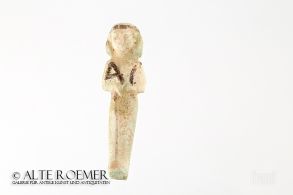 Egyptian ushabti
Egyptian ushabtiFunerary statuette of faience. The opposed hands might indicate Tanis as origin. Third Intermediate Period of Ancient Egypt.
Price: on request Cup of the Urnfield culture
Cup of the Urnfield cultureCeramic vessel dating to the transition period between Bronze Age and Iron Age in Central Europe. 1200 to 800 BC. Found in an urnfield in Austria.
Price: on request Juglet from the Urnfield period
Juglet from the Urnfield periodSmall juglet dating to the transition period between Bronze Age and Iron Age in Central Europe. 1200 to 800 BC. Found in an urnfield in Lower Austria.
Price: on request Big bowl from the Urnfield period
Big bowl from the Urnfield periodCeramic vessel dating to the transition period between Bronze Age and Iron Age in Central Europe. 1200 to 800 BC. Found in an urnfield in Lower Austria.
Price: on request Elamite vessel with painted frieze
Elamite vessel with painted friezeImpressive ceramic jar in prime condition. The geometrical shapes and animals of the frieze are a typical stylistic feature. Found in Susa, from the time of the Ur-III dynasty, around 2000 BC.
Price: on request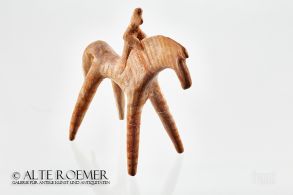 Greek Boeotian rider
Greek Boeotian riderThe painted clay sculpture shows a stylized horse and rider. The rider figurine from Greece dates to the archaic period.
Price: on request Scarab with geometric motive
Scarab with geometric motiveThe lower side exhibits wrapped cords. A nice example of Egyptian art during the Second Intermediate Period. This scarab is described in the catalogue of Irène Gautier-Vodoz.
Price: on request Scarab with lotus motive
Scarab with lotus motiveAncient Egyptian amulet seal with beautiful motive. Six lotus flowers are forming volutes. This scarab is described in the catalogue of Irène Gautier-Vodoz.
Price: on request Skillful golden ring with insert agate
Skillful golden ring with insert agateThe fingerring dates to Late Roman times. It recalls the glory of the rich families of Rome. The elaborately ornamented ring holds an agate stone with beautiful coloured layers.
Price: on request

